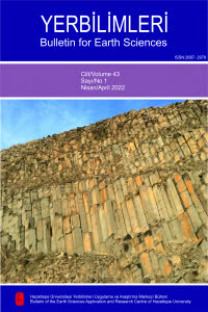Measurement of Radon Exhalation Rates from Different Rock Types and Construction Materials (Gaza Strip, Palestine)
Radon exhalation, building materials, rock fragments, Gaza Strip
___
- Abo-Elmagd, M., and Daif, M.M., 2010. Calibration of CR-39 for radon-related parameters using sealed cup technique. Radiation Protection Dosimetry 139, 546–550. Arrol, W.J., Jacobi, R.B., and Paneth, F.A., 1942. Meteorites and the age of the solar system. Nature 49, 235-238.
- ATSDR (Agency for Toxic Substances and Disease Registry). 1990. U.S Public Health Service, in Collaboration with U.S. Environmental Protection Agency, Toxological Profile For Radon.
- Axelson, O., 1995 Cancer Risks from Exposure to Radon in Homes. Environment Health Perspect 103, 37–43.
- Baykara, O., and Dogru, M., 2006. Measurements of radon and uranium concentration in water and soil samples from East Anatolian Active Fault Systems, Turkey. Radiation Measurements 41, 362–367.
- Baykara, O., Dogrua, M., Inceoz, M., and Aksoy, E., 2005. Measurements of radon emanation from soil samples in triple-junction of North and East Anatolian active faults systems in Turkey. Radiation Measurements 39, 209- 212.
- Chauhan, R. P., Chauhan, P., Pundir, A., Sunil Kamboj, S., Vakul Bansal, V., and Saini, R. S., 2014. Estimation of dose contribution from 226Ra, 232Th and 40K and radon exhalation rates in soil samples from Shivalik Foot Hills in India. Radiation Protection Dosimetry 158, 79–86. Chauhan, R.P., Nain, M, Kant, K., 2008. Radon diffusion studies through some building materials: Effect of grain size. Radiation Measurements 43, S445–S448.
- Chen J., 2005. A Review of radon doses, Radiation Protection Bureau, Health. Canada Radiation Protection 22, 27-31.
- Daly, R.A., 1933. Igneous Rocks and the Depths of the Earth. New York: McGraw-Hill. Durrani, S., and Ilic, R., 1997. Radon Measurements by Etch Track Detectors. World Scientific Publishing, Singapore.
- Evans, R.D., and Goodman, G., 1941. Radioactivity of rocks. Bull. Geol. Soc. Amer. 52, 459-490.
- GEP (Gaza environmental Profile), Part I., 1994. Inventory of resources. Palestinian Environmental protection Authority, Eurconsult/Iwaco.
- Guo Q., and Cheng J., 2005. Indoor thoron and radon concentrations in Zhuhai, China. Journal of Nuclear Science and Technology 42, 588- 591.
- Gurari, F.G., Gavshin, V.M., and Matvienko, N.I., 1984. Geochemistry of Microelements in Lower–Middle Cambrian Marine Plankton Sediments of the Siberian Platform, (Association of Microelements with Organic Matter in Sedimentary Rocks of Siberia). Novosibirsk: Inst. Geol. Geofiz., Sib. Otd., Akad. Nauk SSSR, pp. 41–68.
- ICRP (International Commission on Radiological Protection). 1999. Protection of the Public in Situations of Prolonged Radiation Exposure. Publication 82, Elsevier Science B.V.
- Jacobs, J.A., 1956. Earth`s Interior. In: Incyclopedia of Physics, S. Flugge (ed.), Springer-Verlag, Belin, pp. 389ff.
- Jeffreys, H., 1952. The Earth. 3rd ed., Cambridge University Press.
- Khan, A. J., Prasad, R., and Tyagi, R. K., 1992. Measurement of radon exhalation rate from some building materials. Nuclear Tracks and Radiation Measurements 20, 609-710.
- Khayrat, A.H., Oliver, M.A., Durrani, S.A., 2001. The effect of soil particle size on soil radon concentration. Radiation Measurements 34, 365–371.
- Kochenov, A.V., and Baturin, G.N., 2002. The Paragenesis of Organic Matter, Phosphorus, and Uranium in Marine Sediments. Lithology and Mineral Resources 37 (2), 107-120.
- Maged, A.F., and Ashraf, F.A., 2005. Radon exhalation rate of some building materials used in Egypt. Environmental Geochemistry and Health 27, 485–489.
- Morawska, L., 1989. Two Ways of Determining the 222Rn Emanation Coefficient. Health Phys. 57, 481– 483.
- Najam, L.A., Tawfiq, N.F., and Mahmood, R.H., 2013. Radon Concentration in Some Building Materials in Iraq Using CR-39 Track Detector. International Journal of Physics 1, 73-76.
- NCRP (National Council for Radiation Protection and Measurements), 1987. Report no. 93.
- Rafique, M., and Rathore, M.H., 2013 Determination of radon exhalation from granite, dolerite and marbles decorative stones of the Azad Kashmir area. Pakistan Int. J. Environ. Sci. Technol 10, 1083–1090.
- Senftle, F.E., and Keevil, N.B., 1947. Thorium-uranium ratios in the theory of genesis of lead Ores. Trans. Amer. Geophys. Un. 28, 732- 738.
- Sharma, N., Jaspal Singh, J., Esakki, S.C., Tripathi, R.M., 2016. A study of the natural radioactivity and radon exhalation rate in some cements used in India and its radiological significance. Journal of Radiation Research and Applied Sciences 9, 47-56.
- Singh, A. K., Sengupta, D., and Prasad, R., 1999. Radon exhalation rate and uranium estimation in rock samples from Bihar uranium and copper mines using the SSNTD technique. Appl. Radiat. Isot. 51, 107–113.
- Somogyi, G., 1990. The environmental behaviour of radium. Technical reports series no. 310, vol.1, IAEA, Vienna,247–256.
- Sroor, A., El-Bahi, S.M., Ahmed, F., and Abdel-Haleem, A.S., 2001. Natural radioactivity and radon exhalation rate of soil in southern Egypt. Appl. Radiat. Isot. 55, 873–879.
- Ubeid, K.F., and Albatta, A., 2014. Sand dunes of the Gaza Strip (southwestern Palestine): morphology, textural characteristics and associated environmental impacts. Earth Sciences Research Journal, 18, 131-142.
- Ubeid, K.F., and Ramadan, K.A., 2017. Activity concentration and spatial distribution of radon in beach sands of Gaza Strip, Palestine. Journal of Mediterranean Earth Sciences 9, 19-28.
- UNEP, 2009. Environmental assessment of the Gaza Strip, following the escalation of hostilities in December 2008–January 2009. United Nations Environment Program, Palestine.
- UNSCEAR (United Nations Scientific Committee on the Effects of Atomic Radiation). 2000. Sources and Effects of Ionizing Radiation. New York.
- ISSN: 1301-2894
- Yayın Aralığı: 3
- Başlangıç: 1976
- Yayıncı: Hacettepe Üniversitesi Yerbilimleri Uygulama ve Araştırma Merkezi
Engin MERİÇ, İpek F. BARUT, M. Baki YOKEŞ, MUSTAFA ERYILMAZ, FULYA YÜCESOY ERYILMAZ, FEYZA DİNÇER
Proses Mineralojisinin Flotasyon Tesis Performans Analizinde Kullanımı
İlkay B. CAN, ZAFİR EKMEKÇİ, N. Metin CAN
Farklı Kayaç Tipleri ve Yapı Malzemelerinde Radon Gazı Salınımı Ölçümleri (Gazze Şeriti, Filistin)
Khaled Ahmed RAMADAN, Khalid Fathi UBEİD
Khaled Ahmed RAMADAN, Khalid Fathi UBEİD
İskenderun Körfezi ve Samandağ (Adana-Hatay) kıyılarında gözlenen yabancı bentik foraminiferler
Engin MERİÇ, Niyazi AVŞAR, M. Baki YOKEŞ, FEYZA DİNÇER
Kömür Bileşenlerinin Kalorifik Değer Üzerindeki Etkisi Üzerine Değerlendirme
